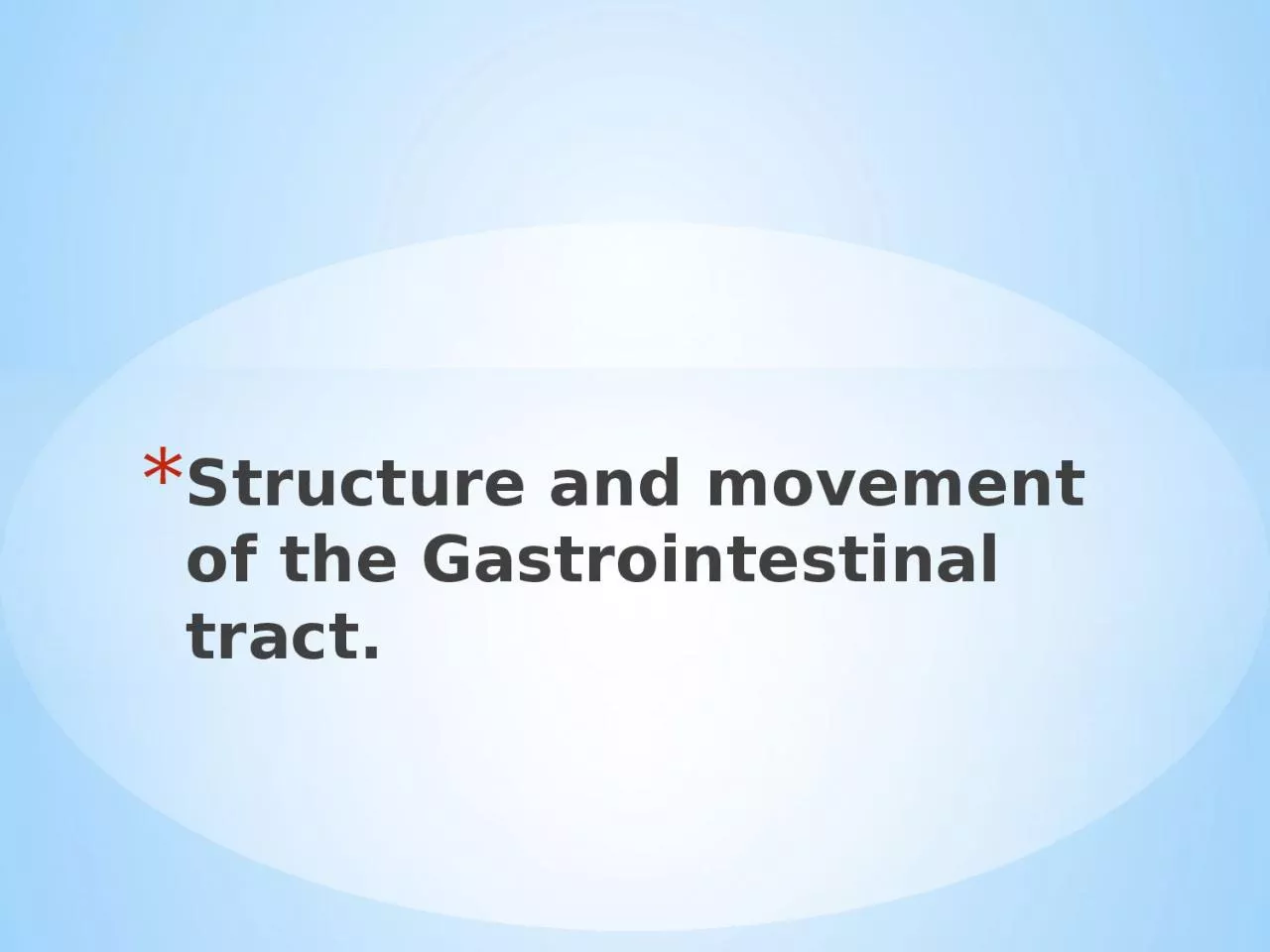

G astrointestinal tract Structure of the gastrointestinal tract The wall of the GIT is divided into 4 layers namely Mucosa Submucosa Muscularis externa Serosa Mucosa Innermost layer with specialized epithelial cells which are supported by underlying connective tissues known as th ID: 1043499
Download Presentation The PPT/PDF document "Structure and movement of the" is the property of its rightful owner. Permission is granted to download and print the materials on this web site for personal, non-commercial use only, and to display it on your personal computer provided you do not modify the materials and that you retain all copyright notices contained in the materials. By downloading content from our website, you accept the terms of this agreement.
1. Structure and movement of the Gastrointestinal tract.
2. Structure of the gastrointestinal tract.The wall of the GIT is divided into 4 layers namely;Mucosa.Submucosa.Muscularis externa.Serosa.
3.
4. Mucosa Innermost layer with specialized epithelial cells which are supported by underlying connective tissues known as the lamina propria.Submucosa.A thick layer of loose connective tissue surrounding the mucosa which contains fat, fibrous tissue and lymphatic vessels, blood vessels and nerves.
5.
6. Muscularis mucosa.A smooth muscle layer containing an inner circular layer and an outer longitudinal layer of muscle fibers seperated by the myenteric plexus or Auerbach plexus.Serosa.This is the outer layer of the GIT and it is formed by fat and another layer of epithelial cell known as the mesothelium.
7.
8. Movement of the GIT.Gut motility is the term given to the stretching and contraction of muscles in the GIT. There are two basic types of movement namelyPropulsive movement- peristalsis.Mixing movement.Propulsive movement-peristalsis.The mechanism of involuntary contraction and relaxation is known as peristalsis.
9.
10. It enables the movement of food down the tract as well as absorption of important nutrients.It begins in the oesophagus when a bolus of food is swallowed.Major stimulus for intestinal peristalsis is distention of the gut.
11.
12. Other stimuli include physical and chemical irritation of epithelial lining in the gut.Perhaps the mucosal irritation stimulates afferent enteric neurons. These neurons synapse with two sets of cholinergic interneurons which leads to two distinct effects
13. One group if interneurons activates excitatory motor neurons above the bolus.Another inhibits motor neurons that stimulate relaxation.
14. Mixng movement.Mixing movement ensures constant mixing of chyme, so that the entire volume of the nutritionally important components is exposed to enzymes and came into a contact with the lining of the intestine to be absorbed. These movements have different forms and varies throughout the digestive tract.
15.
16. Segmentation is well understood mixing movement. We can imagine it as repeated contractions of several centimeters distant sections of circular smooth muscle. Contracted regions differ after each segmentation cycle. Thus is the chyme segmented – formation of separated portions of the chyme, which are subsequently again divided and one half is combined with a portion of the previous one and second portions with the following. Number of portions gradually increases and their volume on the other hand decreases, as one half of the two outer portions always has nowhere to attach and forms a new portion.
17. Motility of the small intestineContractions of the muscle layers of the small intestine can be divided into two groups:1) Segmentation contractions2) Propulsion contractionsSegmentation contractions.Process of the segmentation has already been discussed above. We only briefly discuss its causes here. Segmentation is a manifestation of electrical slow-waves, which represent action potentials generated by the automaticity of smooth muscle. Maximal frequency of these slow waves is 12/min. Therefore, segmentation can also occur up to 12 times per minute, but only in very rare cases. The normal frequency of segmentation movement is about 3 per minute.
18.
19. Propulsion contractionsTheir mechanism has already been described in the introduction part. The contractile ring in the small intestine has a velocity of about 0.5-2 cm/min. Faster in the proximal segments, in distal segments it slows down. One contractile ring travels a maximal distance of 10 cm, then it goes out and chymus wait for the new one. Therefore, the overall speed of passage of chyme is 1 cm/min.
20.
21. Motility of the colonColon has two main functions:to absorb electrolytes and water. to store solid wastes before they are eliminated from the body. Both of these functions require no extensive motor activity. Therefore, the longitudinal muscle layer is in the colon reduced to the taenia. They represent three bands of muscle that stretch along the entire length of the colon. Its motility is thus slower than that of the small intestine.
22. HaustrationIt is a mixing movement of the colon (a modified segmentation movement). First, there is a circular muscle contraction. Subsequently taeniae contract forming the haustrum. Haustra form the characteristic appearance of the colon, which is composed of a series of relatively large bulges. During the contractions of taenia, there is an increased pressure inside haustra. After about 30 seconds the pressure reaches its maximum and in next 60 seconds the haustrum disappears. Formation of a new haustrum starts after several minutes at a new place (segmentation movement), and the whole process is repeated.
23.
24. Propulsion movementsPropulsion movement is mostly determined by the haustration which progressively and slowly progresses from the cecum to the sigmoid colon. Passage of digested material through the colon by haustration held for about 12 hours and the liquid chyme becomes solid fecal matter.
25.